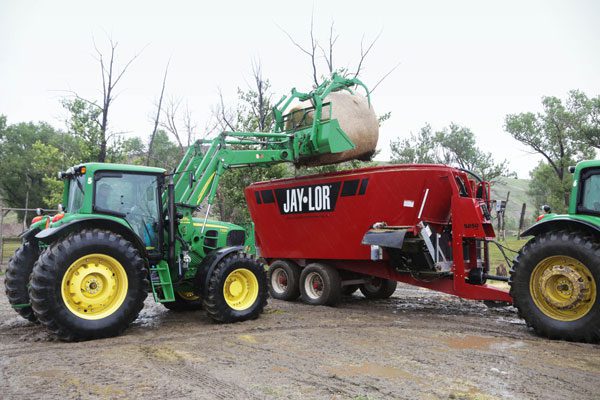How Much Room Is Required To Process Round Bales?
One of the greatest strengths and advantages of Jaylor TMR’s is their industry leading ability to process round bales into total mixed rations. This task is not without its challenges, however, and may not always go as smoothly as desired. The following are some guidelines and tips for processing round bales with Jaylor TMR Mixers.
 The room required to process round bales is a function of the size of a bale, the type of forage, its dry matter content, and the number of bales to be processed. Round bale densities generally range from 8 to 14 lb/cu. ft. (128 to 224 kg/m3) for hay and 6 to 9 lb/cu. ft. (96 to 144 kg/m3) for straw. Variable chamber (hard core) bales will be heavier and fixed chamber (soft core) bales will be lighter. Also, coarser, poorer quality forages will tend to be less dense and make lighter bales than finer and less mature forages, and grass bales may tend to be less dense than legumes (alfalfa) at a similar physiological stage of maturity. High moisture hay and silage bales will be proportionately heavier according to their moisture content, but their DM content will be similar.
The room required to process round bales is a function of the size of a bale, the type of forage, its dry matter content, and the number of bales to be processed. Round bale densities generally range from 8 to 14 lb/cu. ft. (128 to 224 kg/m3) for hay and 6 to 9 lb/cu. ft. (96 to 144 kg/m3) for straw. Variable chamber (hard core) bales will be heavier and fixed chamber (soft core) bales will be lighter. Also, coarser, poorer quality forages will tend to be less dense and make lighter bales than finer and less mature forages, and grass bales may tend to be less dense than legumes (alfalfa) at a similar physiological stage of maturity. High moisture hay and silage bales will be proportionately heavier according to their moisture content, but their DM content will be similar.
During the initial phase of processing, round bales are transformed into a combination of coarsely chopped and long forage with a hay equivalent bulk density ranging from 2 to 4 lb/cu. ft. Density then increases as the particle size decreases to 5 to 7 lb/cu. ft., about the same as loose or unpacked haylage on an equivalent DM basis. From the above we have estimated initial and final TMR mixer volumes required to contain hard core bales of different sizes (Table 1).
Table 1. Volume (cubic feet) occupied by forage in round bales of different sizes at different stages of processing.*
| Round bale size: width x diameter (feet) | |||||
| Stage of processing | 4×4 | 4×5 | 4×6 | 5×5 | 5×6 |
| Intact bale | 50 | 79 | 113 | 98 | 141 |
| Long, coarse chop | 151 | 236 | 339 | 295 | 424 |
| Short, final chop | 86 | 135 | 194 | 168 | 242 |
The volume of forage per bale should be relatively constant across forage type and moisture content within bale size; what will vary mostly will be the weight per bale. The actual room or volume required to process a given size bale may exceed its volume in the long, coarse chop form by 50% or more depending on forage characteristics and processing method. It is not uncommon for forages that are coarser and more resistant to processing to periodically bunch towards one end of the mixer during the initial stages of processing. This can cause some spillage if the size of the mixer is marginal for the quantity and quality of forage being processed.
Ultimately, if round bale forage is expected to comprise a sizeable proportion of a TMR program, and one intends to process large or multiple bales, careful consideration should be given to purchasing a mixer with adequate size to contain the forage during the processing phase. Table 1 can be used to help size mixers for round bale processing. For example, to process two, 5×5 bales per batch, a minimum 590 cu. ft. (2 x 295 cu. ft. per bale) of mixer volume will be required to contain the forage when initially coarsely chopped, assuming no bunching. Therefore a Jaylor 5575 would likely be too small not to expect some spillage; a medium sized twin such as the Jaylor 5650 (with extension) would likely work better.


